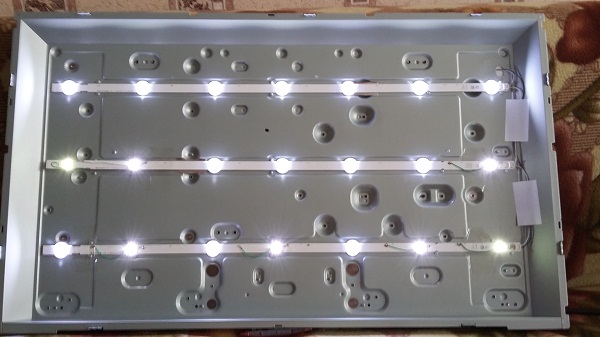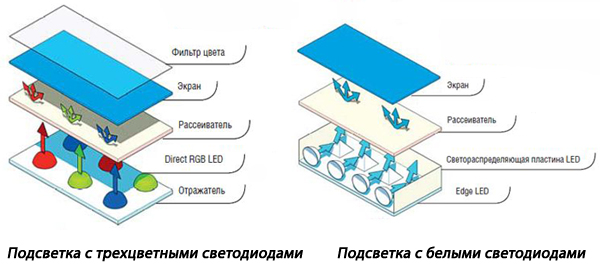Choosing the right TV model, many consumers are faced with new terms and modern technologies. For example, not everyone knows what a TV with LED technology is, and on what principle its operation is based. Despite this, today this type of flat device is most popular among buyers, so they are considered a completely familiar attribute in the house. Before you do it, you should still figure out what the abbreviation LED means, how these TVs differ, and what advantages they have over other types of TVs.
If translated literally, then LED - light emitting diode. However, it is reasonable to believe that it cannot serve as a complete definition. In fact, the modern LED TV is a representative of the well-known liquid crystal panels. The main component is an LCD matrix with many luminous points - pixels. But if in the usual LCD devices fluorescent lamps were used as a backlight, then in the devices under consideration - LEDs, that is, TVs with such a backlight are more advanced options LCD-models.
Samsung developers were the first to use this technology. As a marketing ploy, the new TVs were named LED TV, which is still used today.
LEDs here act as sources of light, and are not a real unit of the forming image. Therefore, it would be more correct to call such panels LCD TV with modern LED backlighting.

Types of LED backlighting
In order to understand what the fundamental feature of such equipment is, it is necessary to understand the types of TV backlighting. Today, several systems are used, they differ in color and method of arrangement.
By the color of the glow sources
- White led or single color system(white LEDs). It is considered a budget solution, but still outperforms fluorescent lamps. LEDs are more energy efficient and mercury free. As for color rendition and depth of coverage, LED TVs with this type of backlighting are not much different from LCD, the difference is more significant for the next version.
- RGB or multi-color system... Their color palette is much wider. This improves color rendering. But it should be noted that models with a similar illumination option are more expensive, which is not commensurate with the achieved effect. Such models require a powerful graphics processor, and they consume more electricity. Since such HDTVs are not affordable for every consumer group, leading companies decide to abandon RGB backlighting, and continue to search for analog technology.
- QD Vision or mixed illumination option... It is based on pure blue LEDs and a special film with quantum dots, which are green and red. This technology makes it possible to emit a strictly limited and tuned spectrum of optical waves. Due to this, the color gamut and intensity of colors are expanded, at the same time, the technology, in contrast to RGB LEDs, is more energy efficient. A striking example of the mixed version of the backlight is the Bravia line of TV panels, the leading manufacturer Triluminos Sony.

In fact, the question of using the first and second backlighting options continues to find a lot of controversial opinions. For example, the famous digital technology developer Toshiba claims that the white backlight of the TV is much more effective than RGB. So why spend tons of money when you can save millions?
By way of backlight placement
There are 2 options here.
- Along the perimeter of the LCD matrix(Edge LED). This is a one-color system (White led), which can be located on one side (most often at the bottom), on parallel sides (on the sides) or around the entire perimeter. The way the side lighting is arranged depends on the size of the screen diagonal. The disadvantages of such a backlight include "flashing" at the edges of the TV screen and insufficient contrast (compared to the second type). But this technology allows you to create panels with a thickness of only a few millimeters.
- Directly behind the LCD(Direct LED). It is based on an even distribution of diodes over the entire area. According to the price criterion, it comes out more expensive than end illumination. The main advantage of such a system is the ability to use local black dimming technology. Both white and colored LEDs can be used here, they significantly improve the image quality.

If you already own such a TV, and you have problems with the image, you may find information about
Advantages of LED TVs
These panels have significant advantages, and therefore are popular among consumers. Of the main advantages, the following factors should be noted.
- Case thickness... It is through the use of LEDs that the production of ultra-thin models has become possible. Such a TV can be easily mounted on a wall using a bracket;
- Contrast and clarity... LED TV is the main competitor to other types of TVs, because it has excellent image reproduction quality, contrast level adjustment. Remembering when problems with the perception of moving objects were observed, it can be noted that such problems will not arise with modern ice screens.
- Energy efficiency... Saving electricity is perhaps the main point that attracts many buyers. Compared to its predecessors, the LED device consumes 40% less resources.
- Wide range of models not only in functionality, but also in appearance. Such a panel will decorate absolutely any interior without any problems. Leading manufacturers have a huge number of models that imply both classic solutions and interesting shapes and colors.
- Durability... Thanks to the use of fade-resistant LEDs, TVs have a longer lifespan.
But the improvement of such TV panels does not end there. Already today on store shelves appearOLEDTV, the illumination of which is based on organic light-emitting diodes. They have an even thinner body, light weight (relative to their diagonal), wide viewing angle, lack of "glare" and glare, excellent color reproduction. However, this does not mean that other models, lower in class, will lose demand. Innovative technologies in this format are not cheap, and the financial capabilities of most consumers will not allow such a widescreen panel at home. Therefore, the demand for simple models of modern LED TVs is unlikely to fall in the near future. Detailed comparative characteristics of both types are given in the article
L



